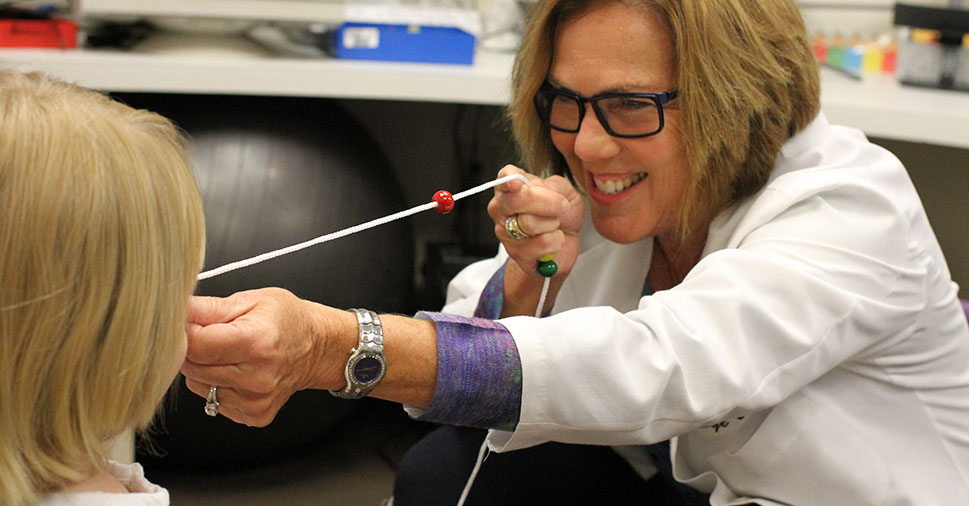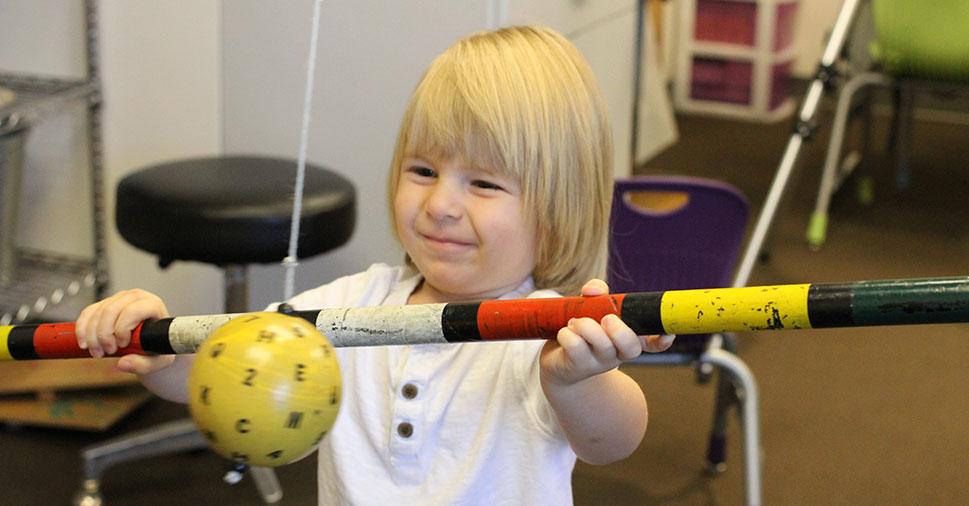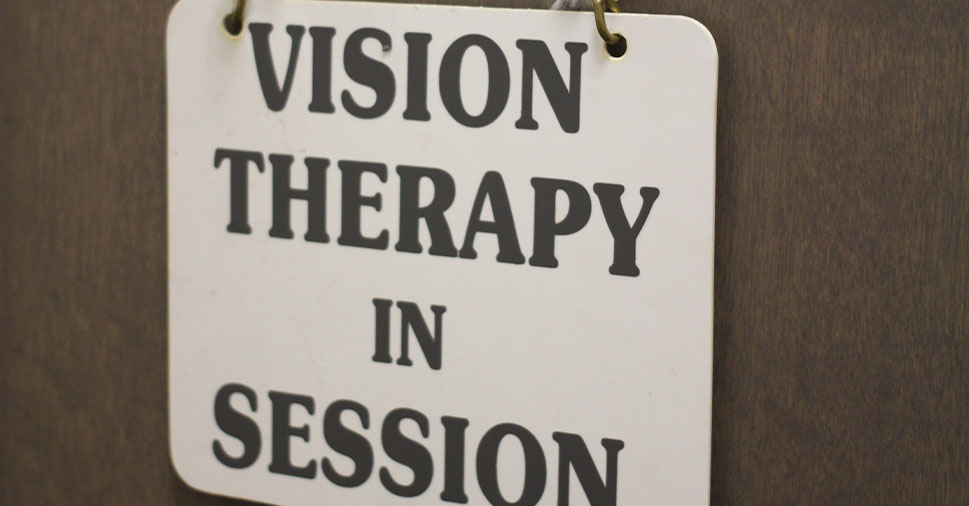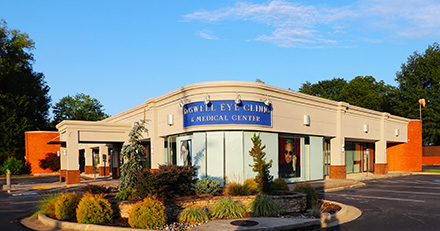Vision Therapy & Sports Vision
What Is Vision Therapy?
Vision Therapy is specifically tailored program to improve a patient’s visual function. Vision therapy is prescribed for individuals of all ages suffering from learning related vision problems, developmental disorders, acquired brain injury, amblyopia, strabismus and/or binocular vision dysfunction.
Some of the common symptoms relieved through Vision Therapy include double vision, poor visual acuity, eyestrain, visually induced headaches, inability to concentrate, loss of place and reversals of letters when reading/writing. Other symptoms often go unrecognized because individuals often develop inefficient coping mechanisms, such as avoiding reading or other visually demanding tasks.
Vision Therapy is an individualized treatment program designed to improve overall visual function and performance by enabling individuals to use their vision more efficiently in order to improve schoolwork, sports performance and avocational/vocational activities. For stroke and acquired brain injury patients, Vision Therapy facilitates appropriate visual rehabilitation and serves as a critical component in the multidisciplinary approach to rehabilitation.
Sight vs. Vision
The ability to see (sight) is a function that most of us are born with but the ability to understand what is seen (vision) is a learned process. Sight is simply one of the five senses, the eyes response to light. 20/20 does not represent perfect vision, but rather is a measure of sight. Vision is a person’s ability to identify, interpret and understand what is seen. Vision involves the eyes, brain and body working together as a team. Visual skill development is as a step by step process as a person grows and matures. If a step is missed or not completed, a vision problem can develop.
Comprehensive Eye Exam vs. Vision Therapy Evaluation
A Comprehensive Eye Examination evaluates the health of the eye from front to back. This examination consists of a refraction to determine a glasses prescription (if needed) and dilation or Optomap photograph to check the health of the back of the eye. If you have vision insurance coverage and are eligible, this appointment may be covered by your vision insurance copay.
A Vision Therapy Evaluation is a more specialized exam that determines the following:
- How the eyes work together as a team
- Range of clear vision
- How efficiently the eyes move from one item to the next when reading
- How the brain processes visual information
Depending on the patient’s diagnosis and medical insurance plan, we can sometimes file the vision therapy evaluation to medical insurance. Due to vision insurance rules, a vision therapy evaluation is never filed to vision insurance.
Visual Skills
Visual skills that can be developed and enhanced through Vision Therapy include:
- Oculomotor skills: The ability to follow along the lines of print of a book. If eye movements are slow, jumpy or clumsy, an individual’s performance can be inhibited. There are two types of oculomotor skills, pursuits and saccades.
- Pursuits: The ability to follow a moving object smoothly and accurately with both eyes, such as moving from the end of one line to the beginning of the next line when reading.
- Saccades: The ability to quickly and accurately locate and inspect a series of stationary objects, one after another, such as moving from word to word while reading.
- Accommodation (focusing) skills: The ability to look quickly from far to near and vice versa without momentary blur, such as looking from chalkboard to a book.
- Binocular Vision (eye teaming) skills: The ability to use both eyes together, smoothly, equally, simultaneously and accurately. Proper eye teaming permits us to see three dimensionally when working with objects in space and to accurately perceive depth and distances between objects. For example, when reading, the eyes converge (or turn in) for proper eye alignment. Common disorders of binocular vision include:
- Strabismus: When the two eyes are not always in perfect alignment due to poor eye teaming skills. Because the two eyes are pointing in different directions, the brain receives confusing signals. Double vision or the suppression of vision in the deviated eye results.
- Amblyopia: This occurs if the brain suppresses the signals from one eye for an extended time period despite that eye being healthy. Amblyopia is often called “lazy eye” because one eye stops functioning properly. The eye-brain connection in the non-functioning eye is poor, and the brain ignores or suppresses most of it’s signals in order to make sense of what is seen. This is caused either by strabismus and/or a glasses prescription where the two eyes are very different.
- Convergence Insufficiency: A sensorimotor anomaly that affects the binocular visual system and is characterized by an inability to adequately converge (turn in) or sustain convergence for visual tasks at near.
- Visual-motor integration (eye-hand coordination): The eyes and hands must be used as paired learning tools. Development in this area is essential when a child learns to write and later learns to read. Eye-hand coordination allows a child the orientation necessary to stay within the lines when writing. This skill is a very important preparatory step for the visual interpretation of words and numbers when reading. It’s also hugely important with most sports.
- Visual Perceptual skills allow us to relate to pictures and words seen on a printed page and discriminate between visible likenesses and differences. Poor memory and inattention to details are often mistakenly cited as the causes of learning related problems. In reality, poor memory and inattention to details are symptoms of poor visual perception.
- Visual Discrimination is the ability to match or determine exact characteristics of two forms when one of the forms is among similar forms.
- Visual Memory is the ability to remember the characteristics of a given form and to find that form in an array of similar forms.
- Visual Spatial Relationship is the ability to determine, from among five forms of identical configuration, the one single form or part of a single form, that is going in a different direction from the others.
- Visual Form Constancy is the ability to see a form, and find that form, even though the form may be smaller, larger, rotated, reversed and/or hidden.
- Visual Sequential Memory is the ability to remember for immediate recall a series of forms from among four separate series of forms.
- Visual Figure Ground is the ability to perceive a form visually and to find this form hidden in a conglomerated ground of matter.
- Visual Closure is the ability to determine from among four incomplete forms the one that is the same as the stimulus (completed form).
Vision and Learning Disabilities
A child who is struggling in school could have a learning-related vision problem, a learning disability or both. Children with learning disabilities may have vision problems that are contributing to their difficulties in the classroom. Vision therapy is a treatment for these contributing vision problems. Be sure to let us know if your child has been diagnosed with a learning disability. If we discover a vision problem that is contributing to difficulties in the classroom, we can communicate with teachers and other specialists to explain our findings and coordinate accommodations. Often, vision therapy can be a helpful component to a multidisciplinary approach to remediating learning problems.
Acquired Brain Injury: Traumatic Brain Injury/Concussions, Stroke and Neurological Dysfunction
What is an Acquired Brain Injury (ABI)?
An ABI is an insult to the brain that can come in many forms including a blow to the head (Traumatic Brain Injury/Concussion), stroke or neurological dysfunction. ABIs can produce a diminished or altered state of consciousness that may result in impairment of cognitive abilities, sensory processing and/or physical function. Impairments can range from mild to severe. Some specific effects are disturbance of behavior or emotional functioning, partial or total functional disability, physiological maladjustment and/or visual dysfunction.
Undetected Visual Problem
Visual problems are often overlooked during the initial treatment of an injury. Not addressing these problems can lengthen and impair rehabilitation. The most important source of sensory information is vision. The visual process involves the flow of information to the brain and the processing of information in the brain. Due to this close relationship between vision and the brain, an Acquired Brain Injury (ABI) can disrupt the visual process. Common visual symptoms that result from an ABI include:
- Blurred Vision (Visual Acuity)
- Sensitivity to Light (Photophobia)
- Reading Difficulties (Oculomotor Skills)
- Words appear to move while reading (Accommodation)
- Comprehension Difficulty (Visual Perception/Oculomotor Skills)
- Memory Difficulty (Visualization)
- Double Vision (Binocularity)
- Aching Eyes (Binocularity/Accommodation)
- Headaches associated with Visual Tasks (Binocularity/Accommodation)
- Loss of Visual Field (Peripheral vision)
- Mobility Difficulties (Depth perception)
Optometry and Rehabilitation
The lack of awareness of visual and visual-perceptual problems resulting from Acquired Brain Injury has historically created a gap in rehabilitative services, which leads to frustration for patients. A Behavioral Optometrist at Roswell Eye Clinic can play an important role in the rehabilitation process. We may prescribe lenses and/or Vision Therapy. Vision therapy is a very practical and effective way to improve an individual’s visual system following an acquired brain injury.
Sports Vision
Vision is a key component in sports. Coordination, concentration, balance and accuracy are a few of the visually-related abilities you use in sports. Athletes of all levels can improve their athletic performance with sports vision training. Some specific skills used in sports include:
- Dynamic Visual Acuity: Clearly seeing an objects while you and/or the object is moving
- Eye Tracking: Accurately keeping your eyes on the target no matter how fast it may be traveling
- Eye Focusing: Quickly changing focus from one distance to another
- Peripheral Vision: Awareness of anything outside of your central vision while focusing
- Depth Perception: Accurately & quickly judging distances and speed
- Visualization: Picturing events using the “mind’s eye
Techniques and Technology in Vision Therapy
Historically, vision therapy mostly involved the use of lenses, prisms, balance boards and balls. In addition to traditional methods, Roswell Eye Clinic now incorporates the following state of the art technology into therapy:
Vivid Vision
A virtual reality system often used in combination with traditional vision therapy treatments and activities. It’s used to treat strabismus, binocular vision disorders, suppression and amblyopia. Vivid Vision allows our vision therapists to have total control of the vision therapy treatment. Vivid vision is designed for kids and adults with stimulating exercises for all skill levels.
Sanet Vision Integrator (SVI)
A programmable, touch screen television designed to improve visual abilities. SVI treatment is used for patients with visually related learning problems, acquired brain injury and amblyopia. Verbal commands can be added to memory and sequencing activities on the SVI help to improve auditory-visual integration. For athletes looking to enhance their skills through sports vision therapy, custom features of the Sanet Vision Integrator aim to enhance pursuits, saccades, eye-hand coordination, fixation stability, speed and span of recognition, visual reaction time, automaticity and contrast sensitivity.
Computer Orthoptics VTS4
A computer program that can be precisely programmed by our Therapists to treat amblyopia, suppression, altered retinal correspondence and strabismus. The patient’s responses during the therapy are used to alter target demands and change the difficulty. The graphics are constantly moving, changing or rotating to keep the patient working throughout the activity. VTS4 improves oculomotor skills, visual memory, accommodative facility and fusional ranges for binocular vision disorders.
Meet Our Therapist
Melissa Snyder, COVT
Melissa began her career at Roswell Eye Clinic in 1993 while pursuing her undergraduate degree in Psychology. She became a Certified Optometric Vision Therapist (COVT) in the College of Optometrists in Vision Development (COVD) in 2014. In order to become a Certified Optometric Vision Therapist, COVD requires 2000 hours of clinical vision therapy experience, successful completion of nine board reviewed essay questions, a written exam and an oral interview with two board members. Melissa serves as the lead Vision Therapist at Roswell Eye Clinic and has over 12,000 hours of clinical vision therapy experience. Melissa also spends time in the community to raise awareness of the benefits and efficacy of vision therapy.
Our Vision Therapy, Sports Vision, Concussion, & Traumatic Brain Injuries’ Specialists: Dr. Emily Felouzis, Dr. Sarah Flanagan, Dr. Michelle Moscow, Dr. Sharon Berger Moscow, Dr. Ashleigh Sprouse
